solar
27th December
2016
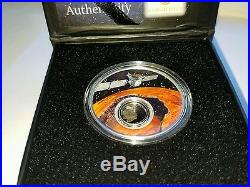







999 Fine with real meteorite is the second release of 4 in the Solar system series. Comes in a gift box and a certificate of authenticity. Minted for the country of Nuie and the 5 dollar denomination of New Zealand. There will be a series of 4 of these with space shuttle parts and things that have been in outer space. With only a mintage of 1000 these rare coins will only increase in value. MAKES A WOUNDERFUL GIFT. The item “2017 Solar System Coin 2nd Release Mission to Mars 1oz Proof with Meteorite” is in sale since Monday, December 12, 2016. This item is in the category “Coins & Paper Money\Bullion\Silver\Coins”. The seller is “pokerkurt1″ and is located in Sun City, California. This item can be shipped to United States, to Canada, to United Kingdom, DK, RO, SK, BG, CZ, FI, HU, LV, LT, MT, EE, to Australia, GR, PT, CY, SI, to Japan, SE, ID, TH, to Belgium, to France, to Hong Kong, to Ireland, to Netherlands, PL, to Spain, to Italy, to Germany, to Austria, SG, to Switzerland, NO, SA, AE, QA, KW, BH, HR, MY, BR, CL, CO.
- Coin: $ 5.00 New Zealand
- Precious Metal Content: 1 oz
- Year: 2017
- Country/Region of Manufacture: Niue
Comments Off
26th December
2016



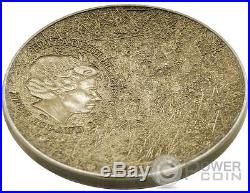

31.1 (1 oz). This beautiful 1 Oz Silver coin, with a real meteorite and yellow Antique Finsh quality, is the second issue of the series “Solar System”. The coin depicts the Mercury surface on both sides, with a concave shape and the insert is a real piece of the NWA 8409 Meteorite. The coin is housed in a prestigious wooden box with Certificate of Authenticity. Extremely low mintage of 686 pieces worldwide! The reverse of the coin depicts the Mercury surface, with very realistic details. What makes this coin unique is a real meteorite called NWA 8409, fallen on Earth in Northwest Africa, inlaid on the coin. On top of the coin the inscription “Solar System Mercury” and on the obverse side the effigy of Her Majesty Queen Elizabeth II. Mercury Mercury is the smallest planet in the Solar System and the one closest to the Sun, with an orbital period of about 88 Earth days, which is much faster than any other planet in the Solar System. Seen from Earth, it appears to move around its orbit in about 116 days. It has no known natural satellites. It is named after the Roman deity Mercury, the messenger to the gods. Partly because it has almost no atmosphere to retain heat, Mercury’s surface temperature varies diurnally more than any other planet in the Solar System, ranging from 100 K (-173 °C; -280 °F) at night to 700 K (427 °C; 800 °F) during the day in some equatorial regions. The poles are constantly below 180 K (-93 °C; -136 °F). Mercury’s axis has the smallest tilt of any of the Solar System’s planets (about 1/30 of a degree). However it has the largest orbital eccentricity: at aphelion, Mercury is about 1.5 times as far from the Sun as it is at perihelion. Mercury’s surface is heavily cratered and similar in appearance to the Moon, indicating that it has been geologically inactive for billions of years. Mercury is gravitationally locked and rotates in a way that is unique in the Solar System. As seen relative to the fixed stars, it rotates on its axis exactly three times for every two revolutions it makes around the Sun. As seen from the Sun, in a frame of reference that rotates with the orbital motion, it appears to rotate only once every two Mercurian years. An observer on Mercury would therefore see only one day every two years. The item “SOLAR SYSTEM MERCURY NWA 8409 Meteorite Silver Coin 1$ Niue 2016″ is in sale since Wednesday, April 13, 2016. This item is in the category “Coins & Paper Money\Coins\ World\Australia & Oceania\South Pacific”. The seller is “powercoin_italy” and is located in Roma. This item can be shipped worldwide.
- Circulated/Uncirculated: Uncirculated
- Year: 2016
- Composition: Silver
- Country/Region of Manufacture: Niue
Comments Off
13th December
2016

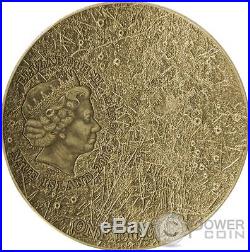



31.1 (1 oz). This beautiful 1 Oz Silver coin, with a real meteorite and yellow Antique Finsh quality, is the second issue of the series “Solar System”. The coin depicts the Mercury surface on both sides, with a concave shape and the insert is a real piece of the NWA 8409 Meteorite. The coin is housed in a prestigious wooden box with Certificate of Authenticity. Extremely low mintage of 686 pieces worldwide! The reverse of the coin depicts the Mercury surface, with very realistic details. What makes this coin unique is a real meteorite called NWA 8409, fallen on Earth in Northwest Africa, inlaid on the coin. On top of the coin the inscription “Solar System Mercury” and on the obverse side the effigy of Her Majesty Queen Elizabeth II. Mercury Mercury is the smallest planet in the Solar System and the one closest to the Sun, with an orbital period of about 88 Earth days, which is much faster than any other planet in the Solar System. Seen from Earth, it appears to move around its orbit in about 116 days. It has no known natural satellites. It is named after the Roman deity Mercury, the messenger to the gods. Partly because it has almost no atmosphere to retain heat, Mercury’s surface temperature varies diurnally more than any other planet in the Solar System, ranging from 100 K (-173 °C; -280 °F) at night to 700 K (427 °C; 800 °F) during the day in some equatorial regions. The poles are constantly below 180 K (-93 °C; -136 °F). Mercury’s axis has the smallest tilt of any of the Solar System’s planets (about 1/30 of a degree). However it has the largest orbital eccentricity: at aphelion, Mercury is about 1.5 times as far from the Sun as it is at perihelion. Mercury’s surface is heavily cratered and similar in appearance to the Moon, indicating that it has been geologically inactive for billions of years. Mercury is gravitationally locked and rotates in a way that is unique in the Solar System. As seen relative to the fixed stars, it rotates on its axis exactly three times for every two revolutions it makes around the Sun. As seen from the Sun, in a frame of reference that rotates with the orbital motion, it appears to rotate only once every two Mercurian years. An observer on Mercury would therefore see only one day every two years. The item “SOLAR SYSTEM MERCURY NWA 8409 Meteorite Silver Coin 1$ Niue 2016″ is in sale since Tuesday, December 06, 2016. This item is in the category “Coins & Paper Money\Coins\ World\Australia & Oceania\South Pacific”. The seller is “powercoin_italy” and is located in Roma. This item can be shipped worldwide.
- Circulated/Uncirculated: Uncirculated
- Year: 2016
- Composition: Silver
- Country/Region of Manufacture: Niue
Comments Off
23rd September
2016





31.1 (1 oz). This beautiful 1 Oz Silver coin, with a real meteorite and yellow Antique Finsh quality, is the second issue of the series “Solar System”. The coin depicts the Mercury surface on both sides, with a concave shape and the insert is a real piece of the NWA 8409 Meteorite. The coin is housed in a prestigious wooden box with Certificate of Authenticity. Extremely low mintage of 686 pieces worldwide! The reverse of the coin depicts the Mercury surface, with very realistic details. What makes this coin unique is a real meteorite called NWA 8409, fallen on Earth in Northwest Africa, inlaid on the coin. On top of the coin the inscription “Solar System Mercury” and on the obverse side the effigy of Her Majesty Queen Elizabeth II. Mercury Mercury is the smallest planet in the Solar System and the one closest to the Sun, with an orbital period of about 88 Earth days, which is much faster than any other planet in the Solar System. Seen from Earth, it appears to move around its orbit in about 116 days. It has no known natural satellites. It is named after the Roman deity Mercury, the messenger to the gods. Partly because it has almost no atmosphere to retain heat, Mercury’s surface temperature varies diurnally more than any other planet in the Solar System, ranging from 100 K (-173 °C; -280 °F) at night to 700 K (427 °C; 800 °F) during the day in some equatorial regions. The poles are constantly below 180 K (-93 °C; -136 °F). Mercury’s axis has the smallest tilt of any of the Solar System’s planets (about 1/30 of a degree). However it has the largest orbital eccentricity: at aphelion, Mercury is about 1.5 times as far from the Sun as it is at perihelion. Mercury’s surface is heavily cratered and similar in appearance to the Moon, indicating that it has been geologically inactive for billions of years. Mercury is gravitationally locked and rotates in a way that is unique in the Solar System. As seen relative to the fixed stars, it rotates on its axis exactly three times for every two revolutions it makes around the Sun. As seen from the Sun, in a frame of reference that rotates with the orbital motion, it appears to rotate only once every two Mercurian years. An observer on Mercury would therefore see only one day every two years. The item “SOLAR SYSTEM MERCURY NWA 8409 Meteorite Silver Coin 1$ Niue 2016″ is in sale since Sunday, September 18, 2016. This item is in the category “Coins & Paper Money\Coins\ World\Australia & Oceania\South Pacific”. The seller is “powercoin_italy” and is located in Roma. This item can be shipped worldwide.
- Circulated/Uncirculated: Uncirculated
- Year: 2016
- Composition: Silver
- Country/Region of Manufacture: Niue
Comments Off
16th September
2016





31.1 (1 oz). This beautiful 1 Oz Silver coin, with a real meteorite and yellow Antique Finsh quality, is the second issue of the series “Solar System”. The coin depicts the Mercury surface on both sides, with a concave shape and the insert is a real piece of the NWA 8409 Meteorite. The coin is housed in a prestigious wooden box with Certificate of Authenticity. Extremely low mintage of 686 pieces worldwide! The reverse of the coin depicts the Mercury surface, with very realistic details. What makes this coin unique is a real meteorite called NWA 8409, fallen on Earth in Northwest Africa, inlaid on the coin. On top of the coin the inscription “Solar System Mercury” and on the obverse side the effigy of Her Majesty Queen Elizabeth II. Mercury Mercury is the smallest planet in the Solar System and the one closest to the Sun, with an orbital period of about 88 Earth days, which is much faster than any other planet in the Solar System. Seen from Earth, it appears to move around its orbit in about 116 days. It has no known natural satellites. It is named after the Roman deity Mercury, the messenger to the gods. Partly because it has almost no atmosphere to retain heat, Mercury’s surface temperature varies diurnally more than any other planet in the Solar System, ranging from 100 K (-173 °C; -280 °F) at night to 700 K (427 °C; 800 °F) during the day in some equatorial regions. The poles are constantly below 180 K (-93 °C; -136 °F). Mercury’s axis has the smallest tilt of any of the Solar System’s planets (about 1/30 of a degree). However it has the largest orbital eccentricity: at aphelion, Mercury is about 1.5 times as far from the Sun as it is at perihelion. Mercury’s surface is heavily cratered and similar in appearance to the Moon, indicating that it has been geologically inactive for billions of years. Mercury is gravitationally locked and rotates in a way that is unique in the Solar System. As seen relative to the fixed stars, it rotates on its axis exactly three times for every two revolutions it makes around the Sun. As seen from the Sun, in a frame of reference that rotates with the orbital motion, it appears to rotate only once every two Mercurian years. An observer on Mercury would therefore see only one day every two years. The item “SOLAR SYSTEM MERCURY NWA 8409 Meteorite Silver Coin 1$ Niue 2016″ is in sale since Tuesday, September 13, 2016. This item is in the category “Coins & Paper Money\Coins\ World\Australia & Oceania\South Pacific”. The seller is “powercoin_italy” and is located in Roma, Lazio. This item can be shipped worldwide.
- Circulated/Uncirculated: Uncirculated
- Year: 2016
- Composition: Silver
- Country/Region of Manufacture: Niue
Comments Off
11th September
2016

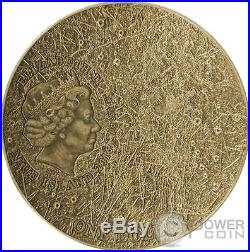

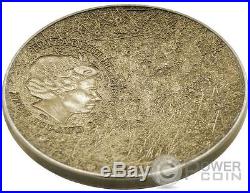

31.1 (1 oz). This beautiful 1 Oz Silver coin, with a real meteorite and yellow Antique Finsh quality, is the second issue of the series “Solar System”. The coin depicts the Mercury surface on both sides, with a concave shape and the insert is a real piece of the NWA 8409 Meteorite. The coin is housed in a prestigious wooden box with Certificate of Authenticity. Extremely low mintage of 686 pieces worldwide! The reverse of the coin depicts the Mercury surface, with very realistic details. What makes this coin unique is a real meteorite called NWA 8409, fallen on Earth in Northwest Africa, inlaid on the coin. On top of the coin the inscription “Solar System Mercury” and on the obverse side the effigy of Her Majesty Queen Elizabeth II. Mercury Mercury is the smallest planet in the Solar System and the one closest to the Sun, with an orbital period of about 88 Earth days, which is much faster than any other planet in the Solar System. Seen from Earth, it appears to move around its orbit in about 116 days. It has no known natural satellites. It is named after the Roman deity Mercury, the messenger to the gods. Partly because it has almost no atmosphere to retain heat, Mercury’s surface temperature varies diurnally more than any other planet in the Solar System, ranging from 100 K (-173 °C; -280 °F) at night to 700 K (427 °C; 800 °F) during the day in some equatorial regions. The poles are constantly below 180 K (-93 °C; -136 °F). Mercury’s axis has the smallest tilt of any of the Solar System’s planets (about 1/30 of a degree). However it has the largest orbital eccentricity: at aphelion, Mercury is about 1.5 times as far from the Sun as it is at perihelion. Mercury’s surface is heavily cratered and similar in appearance to the Moon, indicating that it has been geologically inactive for billions of years. Mercury is gravitationally locked and rotates in a way that is unique in the Solar System. As seen relative to the fixed stars, it rotates on its axis exactly three times for every two revolutions it makes around the Sun. As seen from the Sun, in a frame of reference that rotates with the orbital motion, it appears to rotate only once every two Mercurian years. An observer on Mercury would therefore see only one day every two years. The item “SOLAR SYSTEM MERCURY NWA 8409 Meteorite Silver Coin 1$ Niue 2016″ is in sale since Thursday, September 08, 2016. This item is in the category “Coins & Paper Money\Coins\ World\Australia & Oceania\South Pacific”. The seller is “powercoin_italy” and is located in Roma, Lazio. This item can be shipped worldwide.
- Circulated/Uncirculated: Uncirculated
- Year: 2016
- Composition: Silver
- Country/Region of Manufacture: Niue
Comments Off
28th June
2016





31.1 (1 oz). This beautiful 1 Oz Silver coin, with a real meteorite and yellow Antique Finsh quality, is the second issue of the series “Solar System”. The coin depicts the Mercury surface on both sides, with a concave shape and the insert is a real piece of the NWA 8409 Meteorite. The coin is housed in a prestigious wooden box with Certificate of Authenticity. Extremely low mintage of 686 pieces worldwide! The reverse of the coin depicts the Mercury surface, with very realistic details. What makes this coin unique is a real meteorite called NWA 8409, fallen on Earth in Northwest Africa, inlaid on the coin. On top of the coin the inscription “Solar System Mercury” and on the obverse side the effigy of Her Majesty Queen Elizabeth II. Mercury Mercury is the smallest planet in the Solar System and the one closest to the Sun, with an orbital period of about 88 Earth days, which is much faster than any other planet in the Solar System. Seen from Earth, it appears to move around its orbit in about 116 days. It has no known natural satellites. It is named after the Roman deity Mercury, the messenger to the gods. Partly because it has almost no atmosphere to retain heat, Mercury’s surface temperature varies diurnally more than any other planet in the Solar System, ranging from 100 K (-173 °C; -280 °F) at night to 700 K (427 °C; 800 °F) during the day in some equatorial regions. The poles are constantly below 180 K (-93 °C; -136 °F). Mercury’s axis has the smallest tilt of any of the Solar System’s planets (about 1/30 of a degree). However it has the largest orbital eccentricity: at aphelion, Mercury is about 1.5 times as far from the Sun as it is at perihelion. Mercury’s surface is heavily cratered and similar in appearance to the Moon, indicating that it has been geologically inactive for billions of years. Mercury is gravitationally locked and rotates in a way that is unique in the Solar System. As seen relative to the fixed stars, it rotates on its axis exactly three times for every two revolutions it makes around the Sun. As seen from the Sun, in a frame of reference that rotates with the orbital motion, it appears to rotate only once every two Mercurian years. An observer on Mercury would therefore see only one day every two years. The item “SOLAR SYSTEM MERCURY NWA 8409 Meteorite Silver Coin 1$ Niue 2016″ is in sale since Thursday, June 23, 2016. This item is in the category “Coins & Paper Money\Coins\ World\Australia & Oceania\South Pacific”. The seller is “powercoin_italy” and is located in Roma. This item can be shipped worldwide.
- Circulated/Uncirculated: Uncirculated
- Year: 2016
- Composition: Silver
- Country/Region of Manufacture: Niue
Comments Off
18th May
2016





31.1 (1 oz). This beautiful 1 Oz Silver coin, with a real meteorite and yellow Antique Finsh quality, is the second issue of the series “Solar System”. The coin depicts the Mercury surface on both sides, with a concave shape and the insert is a real piece of the NWA 8409 Meteorite. The coin is housed in a prestigious wooden box with Certificate of Authenticity. Extremely low mintage of 686 pieces worldwide! The reverse of the coin depicts the Mercury surface, with very realistic details. What makes this coin unique is a real meteorite called NWA 8409, fallen on Earth in Northwest Africa, inlaid on the coin. On top of the coin the inscription “Solar System Mercury” and on the obverse side the effigy of Her Majesty Queen Elizabeth II. Mercury Mercury is the smallest planet in the Solar System and the one closest to the Sun, with an orbital period of about 88 Earth days, which is much faster than any other planet in the Solar System. Seen from Earth, it appears to move around its orbit in about 116 days. It has no known natural satellites. It is named after the Roman deity Mercury, the messenger to the gods. Partly because it has almost no atmosphere to retain heat, Mercury’s surface temperature varies diurnally more than any other planet in the Solar System, ranging from 100 K (-173 °C; -280 °F) at night to 700 K (427 °C; 800 °F) during the day in some equatorial regions. The poles are constantly below 180 K (-93 °C; -136 °F). Mercury’s axis has the smallest tilt of any of the Solar System’s planets (about 1/30 of a degree). However it has the largest orbital eccentricity: at aphelion, Mercury is about 1.5 times as far from the Sun as it is at perihelion. Mercury’s surface is heavily cratered and similar in appearance to the Moon, indicating that it has been geologically inactive for billions of years. Mercury is gravitationally locked and rotates in a way that is unique in the Solar System. As seen relative to the fixed stars, it rotates on its axis exactly three times for every two revolutions it makes around the Sun. As seen from the Sun, in a frame of reference that rotates with the orbital motion, it appears to rotate only once every two Mercurian years. An observer on Mercury would therefore see only one day every two years. The item “SOLAR SYSTEM MERCURY NWA 8409 Meteorite Silver Coin 1$ Niue 2016″ is in sale since Saturday, May 14, 2016. This item is in the category “Coins & Paper Money\Coins\ World\Australia & Oceania\South Pacific”. The seller is “powercoin_italy” and is located in Roma. This item can be shipped worldwide.
- Circulated/Uncirculated: Uncirculated
- Year: 2016
- Composition: Silver
- Country/Region of Manufacture: Niue
Comments Off
6th May
2016




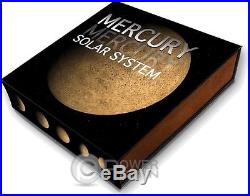
31.1 (1 oz). This beautiful 1 Oz Silver coin, with a real meteorite and yellow Antique Finsh quality, is the second issue of the series “Solar System”. The coin depicts the Mercury surface on both sides, with a concave shape and the insert is a real piece of the NWA 8409 Meteorite. The coin is housed in a prestigious wooden box with Certificate of Authenticity. Extremely low mintage of 686 pieces worldwide! The reverse of the coin depicts the Mercury surface, with very realistic details. What makes this coin unique is a real meteorite called NWA 8409, fallen on Earth in Northwest Africa, inlaid on the coin. On top of the coin the inscription “Solar System Mercury” and on the obverse side the effigy of Her Majesty Queen Elizabeth II. Mercury Mercury is the smallest planet in the Solar System and the one closest to the Sun, with an orbital period of about 88 Earth days, which is much faster than any other planet in the Solar System. Seen from Earth, it appears to move around its orbit in about 116 days. It has no known natural satellites. It is named after the Roman deity Mercury, the messenger to the gods. Partly because it has almost no atmosphere to retain heat, Mercury’s surface temperature varies diurnally more than any other planet in the Solar System, ranging from 100 K (-173 °C; -280 °F) at night to 700 K (427 °C; 800 °F) during the day in some equatorial regions. The poles are constantly below 180 K (-93 °C; -136 °F). Mercury’s axis has the smallest tilt of any of the Solar System’s planets (about 1/30 of a degree). However it has the largest orbital eccentricity: at aphelion, Mercury is about 1.5 times as far from the Sun as it is at perihelion. Mercury’s surface is heavily cratered and similar in appearance to the Moon, indicating that it has been geologically inactive for billions of years. Mercury is gravitationally locked and rotates in a way that is unique in the Solar System. As seen relative to the fixed stars, it rotates on its axis exactly three times for every two revolutions it makes around the Sun. As seen from the Sun, in a frame of reference that rotates with the orbital motion, it appears to rotate only once every two Mercurian years. An observer on Mercury would therefore see only one day every two years. The item “SOLAR SYSTEM MERCURY NWA 8409 Meteorite Silver Coin 1$ Niue 2016″ is in sale since Wednesday, May 04, 2016. This item is in the category “Coins & Paper Money\Coins\ World\Australia & Oceania\South Pacific”. The seller is “powercoin_italy” and is located in Roma. This item can be shipped worldwide.
- Circulated/Uncirculated: Uncirculated
- Year: 2016
- Composition: Silver
- Country/Region of Manufacture: Niue
Comments Off
1st May
2016
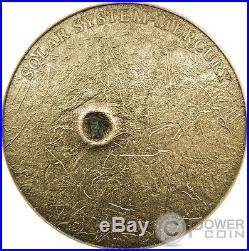




31.1 (1 oz). This beautiful 1 Oz Silver coin, with a real meteorite and yellow Antique Finsh quality, is the second issue of the series “Solar System”. The coin depicts the Mercury surface on both sides, with a concave shape and the insert is a real piece of the NWA 8409 Meteorite. The coin is housed in a prestigious wooden box with Certificate of Authenticity. Extremely low mintage of 686 pieces worldwide! The reverse of the coin depicts the Mercury surface, with very realistic details. What makes this coin unique is a real meteorite called NWA 8409, fallen on Earth in Northwest Africa, inlaid on the coin. On top of the coin the inscription “Solar System Mercury” and on the obverse side the effigy of Her Majesty Queen Elizabeth II. Mercury Mercury is the smallest planet in the Solar System and the one closest to the Sun, with an orbital period of about 88 Earth days, which is much faster than any other planet in the Solar System. Seen from Earth, it appears to move around its orbit in about 116 days. It has no known natural satellites. It is named after the Roman deity Mercury, the messenger to the gods. Partly because it has almost no atmosphere to retain heat, Mercury’s surface temperature varies diurnally more than any other planet in the Solar System, ranging from 100 K (-173 °C; -280 °F) at night to 700 K (427 °C; 800 °F) during the day in some equatorial regions. The poles are constantly below 180 K (-93 °C; -136 °F). Mercury’s axis has the smallest tilt of any of the Solar System’s planets (about 1/30 of a degree). However it has the largest orbital eccentricity: at aphelion, Mercury is about 1.5 times as far from the Sun as it is at perihelion. Mercury’s surface is heavily cratered and similar in appearance to the Moon, indicating that it has been geologically inactive for billions of years. Mercury is gravitationally locked and rotates in a way that is unique in the Solar System. As seen relative to the fixed stars, it rotates on its axis exactly three times for every two revolutions it makes around the Sun. As seen from the Sun, in a frame of reference that rotates with the orbital motion, it appears to rotate only once every two Mercurian years. An observer on Mercury would therefore see only one day every two years. The item “SOLAR SYSTEM MERCURY NWA 8409 Meteorite Silver Coin 1$ Niue 2016″ is in sale since Friday, April 29, 2016. This item is in the category “Coins & Paper Money\Coins\ World\Australia & Oceania\South Pacific”. The seller is “powercoin_italy” and is located in Roma. This item can be shipped worldwide.
- Circulated/Uncirculated: Uncirculated
- Year: 2016
- Composition: Silver
- Country/Region of Manufacture: Niue
Comments Off

